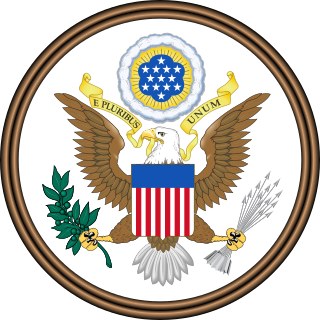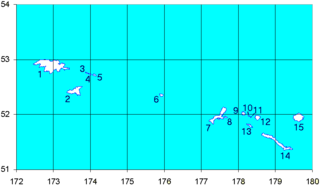
The United States Minor Outlying Islands is a statistical designation applying to the minor outlying islands and groups of islands that comprise eight United States insular areas in the Pacific Ocean and one in the Caribbean Sea.

The United States Fish and Wildlife Service is a U.S. federal government agency within the United States Department of the Interior which oversees the management of fish, wildlife, and natural habitats in the United States. The mission of the agency is "working with others to conserve, protect, and enhance fish, wildlife, plants and their habitats for the continuing benefit of the American people."

The Endangered Species Act of 1973 is the primary law in the United States for protecting and conserving imperiled species. Designed to protect critically imperiled species from extinction as a "consequence of economic growth and development untempered by adequate concern and conservation", the ESA was signed into law by President Richard Nixon on December 28, 1973. The Supreme Court of the United States described it as "the most comprehensive legislation for the preservation of endangered species enacted by any nation". The purposes of the ESA are two-fold: to prevent extinction and to recover species to the point where the law's protections are not needed. It therefore "protect[s] species and the ecosystems upon which they depend" through different mechanisms. For example, section 4 requires the agencies overseeing the Act to designate imperiled species as threatened or endangered. Section 9 prohibits unlawful 'take,' of such species, which means to "harass, harm, hunt..." Section 7 directs federal agencies to use their authorities to help conserve listed species. The Act also serves as the enacting legislation to carry out the provisions outlined in The Convention on International Trade in Endangered Species of Wild Fauna and Flora (CITES).

Histioteuthis is a genus of squid in the family Histioteuthidae. It goes by the common name cock-eyed squid, because in all species the right eye is normal-sized, round, blue and sunken; whereas the left eye is at least twice the diameter of the right eye, tubular, yellow-green, faces upward, and bulges out of the head.

Hawadax Island is an island in the Rat Islands archipelago of the western Aleutian Islands in the U.S. state of Alaska. The island was formerly known as Rat Island until May 2012 when it was renamed Hawadax Island, which is an Aleut name meaning "entry" and "welcome". The island has a land area of 10.72 square miles (27.8 km2) and no permanent population. It is within the Alaska Maritime National Wildlife Refuge.

Driftless Area National Wildlife Refuge is a United States National Wildlife Refuge in northeastern Iowa, southwestern Wisconsin and northwestern Illinois. It is a collection of non-contiguous parcels in the vicinity of the Upper Mississippi River National Wildlife and Fish Refuge.

Histioteuthis bonnellii, the umbrella squid, is a species of cock-eyed squid belonging to the family Histioteuthidae.

The Lower Rio Grande Valley National Wildlife Refuge is a 90,788-acre (367.41 km2) National Wildlife Refuge located in the Lower Rio Grande Valley region of southern Texas.
Austroperipatus is a genus of oviparous and ovoviviparous velvet worms in the family Peripatopsidae and the genus Austroperipatus. This genus has 15 pairs of legs in both sexes. The species in this genus are found in northern Queensland, Australia.
Histioteuthis celeteria, also known as the elegant jewel squid, is a species of cock-eyed squid. The species is distributed across the Atlantic Ocean, and can be found from aa depth of 0 meters to a depth of about 1,010 m (3,310 ft). The maximum length of the species is 8.7 cm (3.4 in).
Histioteuthis cerasina is a species of cock-eyed squid. The species can be found residing in multiple places, including off the coast of Chile.
Histioteuthis corona is a species of cock-eyed squid. The species has been observed sporadically in the Pacific and Atlantic oceans, and is also largely concentrated off the coast of Florida in the Gulf of Mexico.
Histioteuthis macrohista is a species of cock-eyed squid. The species has been documented ~35 times off of the southern coast of Australia, and has also been observed in New Zealand.
Histioteuthis inermis is a species of cock-eyed squid. The species is heavily concentrated in the Mediterranean Sea but has been observed i numerous other parts of the world, including off the coasts of the eastern United States, South Africa, Australia and India.
Histioteuthis atlantica is a species of cock-eyed squid. The species has been observer an estimated 92 times since records began, all off the coast of southern Australia, particularly near Tasmania. It was described by zoologist William Evans Hoyle in 1885.
Histioteuthi pacifica is a species of cock-eyed squid. The species has been documented off the coasts of Bangladesh and Australia.
Histioteuthis oceani is a species of cock-eyed squid. The species can be found residing within the Atlantic and Pacific oceans.
Histioteuthis miranda is a species of cock-eyed squid. The species largely resides in the Indo-Pacific Ocean, and members are gonochoric.
Histioteuthis berryi is a species of cock-eyed squid. The species believed to reside largely in the North Atlantic Ocean, and have also been observed off the coast of California.







